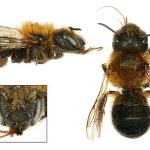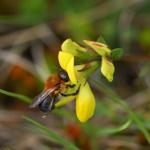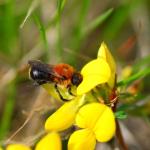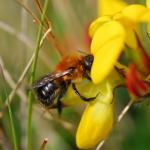Osmia laticeps THOMSON 1872; Osmia svenssoni TKALCŮ 1983
Several years ago, D B Baker and G R Else found that the series of Scottish Osmia inermis in the Natural History Museum, London, consisted of two closely related species: O. inermis and O. uncinata. The latter was a species not previously known from the British Isles.
Osmia uncinata, in common with O. inermis, is confined to the Highlands of Scotland, but it seems to be less localised, with records from Highland Region: Speyside (Kincraig to Nethy Bridge), Ardersier and Bonar Bridge (Else & Edwards, 1996). It is occasionally locally numerous. Other sites worth investigating for the presence of this species are Deeside (Grampian Region) and Glen Affric (Highland Region).
Listed as Vulnerable (RDB2) in Shirt (1987) and Falk (1991).
Osmia uncinata is closely associated with remnants of the ancient Caledonian Forest, specimens being encountered in woodland clearings, along paths through woodland, and on adjacent roadside verges where the main forage plant, bird's-foot-trefoil (Lotus corniculatus), is well established.
Late April or May to early July. Single-brooded.
Nests of this bee have not been found in Scotland. In Germany, females of Osmia uncinata nest in bark on trunks and stumps of pines and sometimes in small detached pieces lying on the ground (Stoeckhert, 1933). The bevelled cutting-edge of the female's mandible suggests that the cell walls are constructed with leaf mastic. More details may be found in Else and Edwards (1996).
In Speyside, both sexes have been observed visiting bird's-foot-trefoil (Lotus corniculatus), broom (Cytisus scoparius) and bilberry (Vaccinium myrtillus)(Else & Edwards, 1996). In Germany, the bee is reported to be polylectic (Westrich, 1989).
The chrysidid wasp Chrysura hirsuta may be a parasitoid of this bee as the wasp has been found in woodland sites where O. uncinata also occurs (C. hirsuta is a known parasitoid of O. inermis, but this bee is not found in woodland).
Profile written: 1998
Proofed: February 2012





